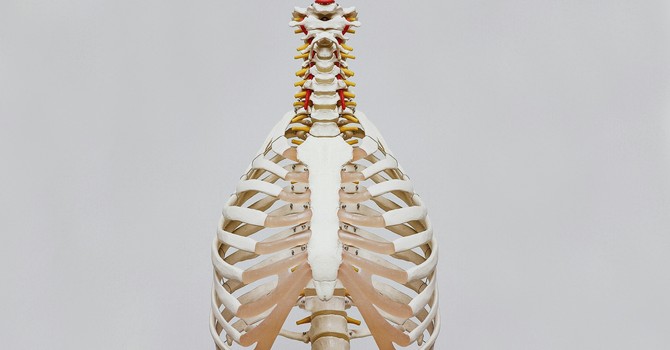Breathing is increasingly being recognized as a way to manage stress and pain. The diaphragm is the primary muscle of respiration and it is well known that there are benefits to diaphragmatic breathing.
The diaphragm is a dome-shaped muscle located below the lungs and heart. When we breathe in, it domes down, allowing air to be drawn into our lungs. When we breathe out, it domes up, pushing air out of our lungs.
The diaphragm’s attachments are widespread. It attaches to the inner surfaces of the lower ribs, lumbar spine, and xiphoid process (the lowest tip of our breast bone). Along with these attachments, its location lends itself to close relationships with a few of our core muscles - the transverse abdominis, rectus abdominis, quadratus lumborum, and psoas. Given its location, function, and these relationships, the diaphragm contributes to core and pelvic function. Here are 3 things to know about the diaphragm and our core:
1. The diaphragm works with the abdominal muscles to control intra-abdominal pressure.
Intra-abdominal pressure is the pressure in the abdominal cavity, which is the space below the diaphragm that contains many of our organs.
When the diaphragm and abdominals contract at the same time, intra-abdominal pressure is increased. The diaphragm domes down into the abdominal cavity while the abdominals act like a corset being tightened. They squeeze and decrease the volume of the space they encase.
This is useful when we need to push something out like during a bowel movement, or during child birth (Gorman, 2023). It can also provide us with increased trunk stability, say when lifting a heavy load (Lee & Lee, 2011).
There is a time and a place for intra-abdominal pressure. It’s not comfortable or adaptive to have high intra-abdominal pressure all the time. In my clinical experience, intra-abdominal pressure is an important consideration in managing incontinence, pelvic organ prolapse, abdominal region pain, and pelvic pain.
2. The diaphragm is connected with our hips and pelvic floor through fascia.
Part of the diaphragm, called the medial arcuate ligament, is contained within the fascia of the psoas muscle (a hip flexor and deep core muscle). Dysfunction of the diaphragm may affect psoas function, and vice versa (Chaitow & Lovegrove Jones, 2012). Lower down in the body, the psoas fascia is continuous with the pelvic floor fascia (Chaitow & Lovegrove Jones, 2012).
3. The diaphragm and pelvic floor work together.
When diaphragmatic breathing is optimal, the diaphragm and pelvic floor mirror each other’s movements, like this:
- Breathe in - Diaphragm and pelvic floor dome down. Pelvic floor muscles relax and lengthen.
- Breathe out - Diaphragm and pelvic floor dome up. Pelvic floor muscles shorten and contract.
Diaphragmatic breathing can help facilitate pelvic floor relaxation and contraction. However, dysfunctional breathing patterns are commonly seen in people with low back pain, pelvic floor and pelvic girdle dysfunction, chronic pelvic pain, and stress incontinence (Chaitow & Lovegrove Jones, 2012).
Improving breathing patterns through detailed assessment of the trunk, especially those parts that the diaphragm attaches to and holds close relationships with, can help rehabilitation of the core, pelvic girdle and pelvic floor.
References
Chaitow, L., & Lovegrove Jones, R. (2012). Chronic pelvic pain and dysfunction: Practical physical medicine. Churchill Livingstone Elselvier.
Gorman, N. (2023, September 19). Diaphragm. Kenhub. https://www.kenhub.com/en/library/anatomy/diaphragm
Lee, D., & Lee, L.-J. (2011). The Pelvic Girdle: An Integration of Clinical Expertise and Research(Fourth Edition). Elsevier Health Sciences UK.





